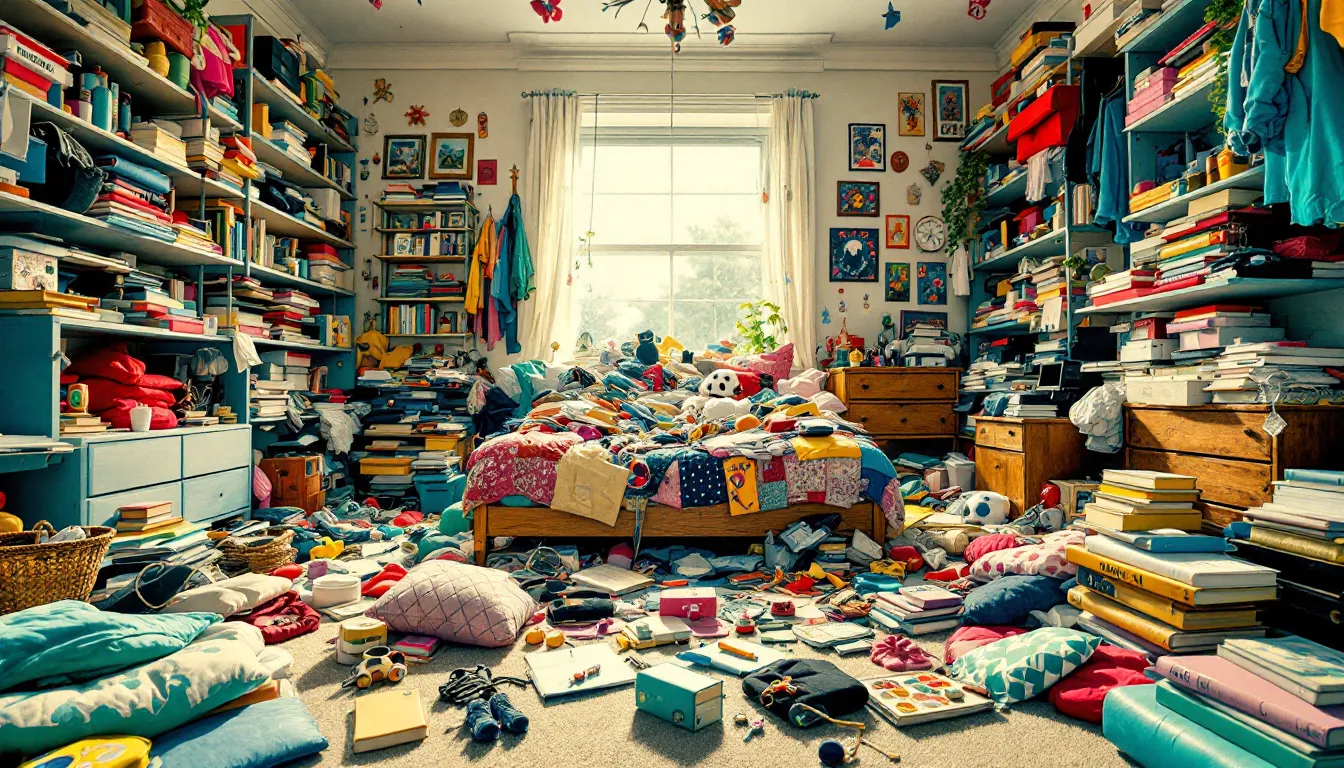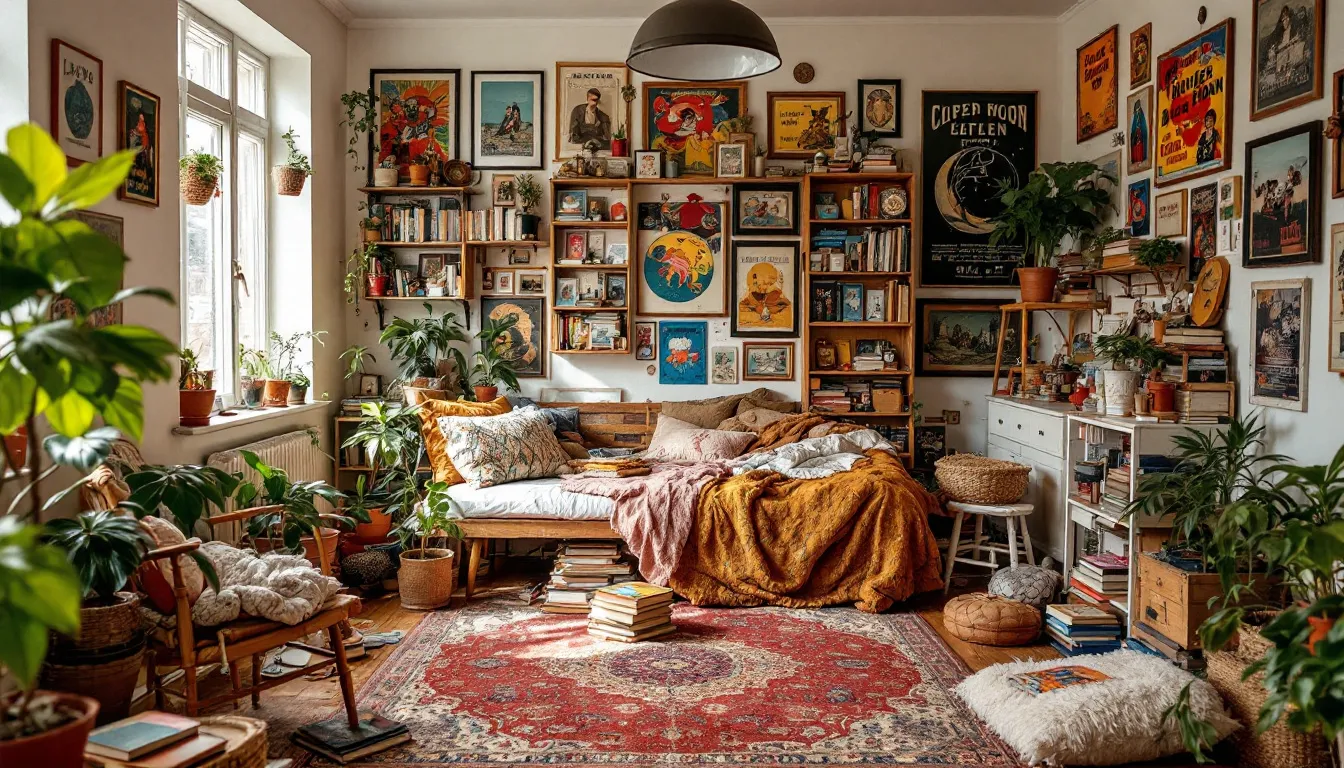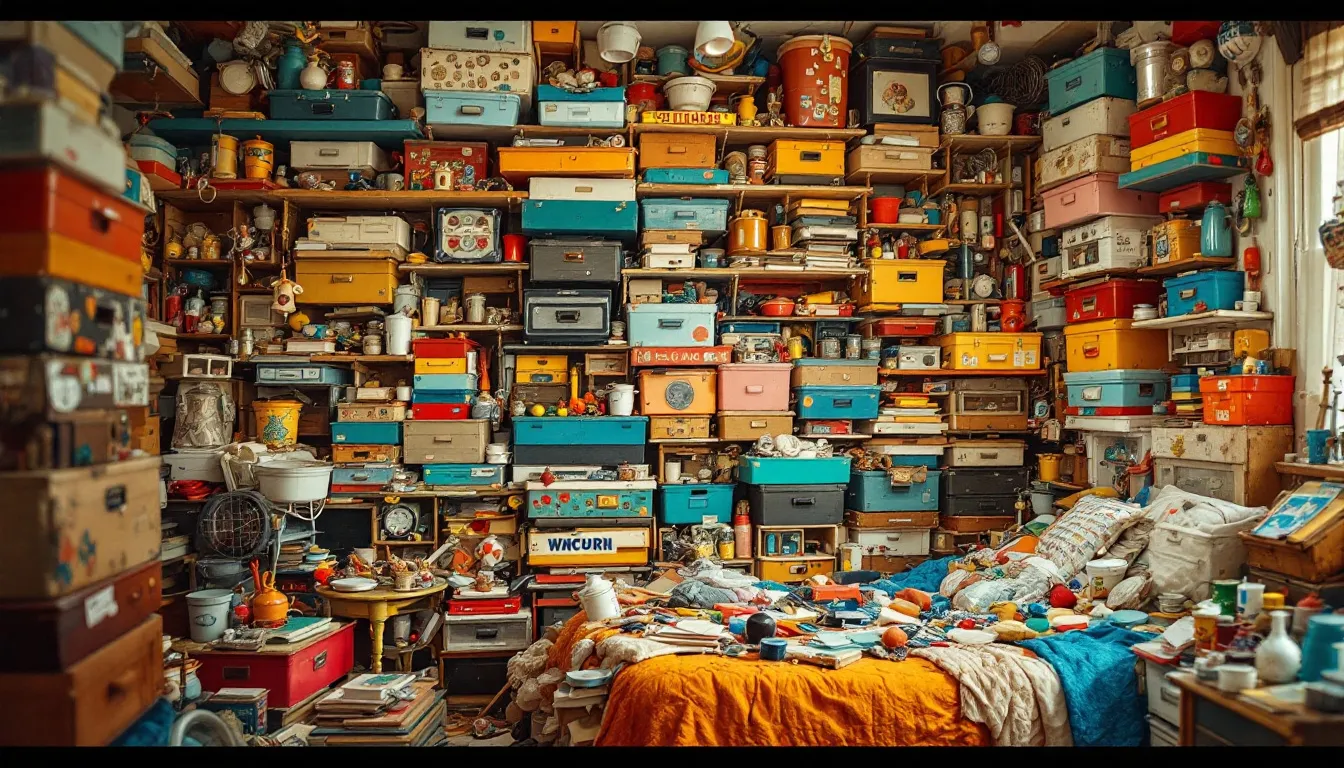Best strategies for organizing a hoarders bedroom

Best Strategies for Organizing a Hoarders Bedroom
Is your bedroom overflowing with clutter? Whether you’re a hoarder or helping someone who is, this guide covers essential steps to clean and organize a hoarder’s bedroom effectively. A hoarder’s bedroom can often feel overwhelming, but with the right approach, you can create a more serene space in a hoarder’s bedroom.
Key Takeaways
Start by tackling the emotional aspects of decluttering to make better decisions about what to keep or discard.
Use a categorized sorting system and methods like the four-box approach to simplify the decluttering process.
Establishing a daily maintenance routine and seeking ongoing support are crucial for long-term organization.
Assessing the Mess

The first step in conquering the chaos is to assess the mess at home. Taking pictures of the current state of the bedroom provides valuable visual documentation and helps track progress over time. This simple act of action can be satisfying, making the change transformation visible and incredibly motivating. Additionally, creating a video of the process can enhance motivation. Don’t forget to watch your progress as you go.
Understanding the emotional response to letting go of belongings is crucial. Hoarders often feel anxious or distressed at the thought of discarding items. Recognizing these feelings is the first step in addressing them:
Acknowledge these emotions as valid and indicative of deeper hoarding-related issues.
Face these emotional challenges.
Start to make better decisions about which items to keep or discard.
Addressing these emotional challenges upfront can aid in reducing anxiety throughout the decluttering process. Awareness and preparation can lead to more informed and less emotionally charged decisions. This understanding sets the stage for the beginning of the next crucial step: categorizing items.
Categorizing Items
Once you have a clear understanding of the mess, the next step is to categorize your items. Establishing a sorting system is essential for streamlining decision-making and creating an organized environment. The key is to categorize belongings into groups such as:
Keep
Donate
Sell
Discard This method simplifies the process and makes it easier to decide what stays and what goes.
Grouping similar items together can significantly enhance the organization of the space. When similar items are grouped, it becomes easier to find what you need, putting reducing the time spent searching through clutter. This approach not only helps in maintaining order but also makes the space more functional and pleasant to live in.
The combined approach of sorting and grouping leads to a more efficient organization of space in a hoarder’s bedroom. Clear categories and grouping similar items together create a structured, more manageable, and maintainable environment. This structured approach sets the foundation for the next step: decluttering.
Decluttering Strategies

Decluttering can be a daunting task, especially for hoarders who often struggle with letting go of items. However, starting the sorting process in less emotionally charged areas can help build momentum and confidence:
Begin with areas that are less emotionally charged.
Tackle these areas first to make it easier to let go of items.
Focus on items that are less likely to be tied to strong emotional attachments.
One effective method for decluttering is the four-box method, which involves sorting items into four categories:
Keep
Donate
Recycle
This method provides a clear and systematic approach to decluttering, making the process more manageable. Setting aside sentimental items for later review is also crucial to avoid overwhelming emotional reactions during categorization.
Working in small sections and completing one area before moving on to another can prevent feelings of being overwhelmed. Benefits of this approach include:
Systematic sorting can reduce cleanup time by up to 40% compared to random decluttering methods.
Breaking the task into smaller, more manageable pieces helps maintain focus.
Ensures steady progress throughout the task.
Creating a Functional Layout

With the clutter under control, the next step is to create a functional layout for the bedroom. Evaluating the safety of the bedroom is crucial, as clutter can block pathways and create hazardous conditions. Assessing how clutter affects daily living can help prioritize which areas need immediate attention and organizing.
An effective layout considers the flow of movement and accessibility within the room, ensuring that essential items are easily reachable. Multi-functional furniture like storage ottomans optimizes space and reduces clutter. This approach allows for a more efficient use of the available area, making the room more functional and aesthetically pleasing. Additionally, it can help to log the organization of items for better management.
Maximizing vertical space for storage is another key aspect of creating a functional layout. Utilizing shelves, hooks, and wall-mounted storage solutions can keep floors clear and provide easy access to frequently used items. Incorporating drawer dividers in nightstands can also help keep smaller items organized and prevent clutter from accumulating.
Storage Solutions

Effective storage solutions are essential for maintaining an organized bedroom. Using labeled bins simplifies the process of locating items and keeps the space organized. This method ensures that everything has a designated place, reducing the chances of clutter reaccumulating.
Temporary storage solutions, such as portable units, can be invaluable during the reorganization process. These units can hold items and things until decisions are made about their placement, providing flexibility and easing the transition to a more organized space. Under-bed storage options are also excellent for maximizing unused areas and keeping items out of sight.
Small, stackable bins can help organize various items within closets or on shelves, making it easier to maintain order. These solutions not only optimize space but also make it easier to find and access items when needed. With the right storage solutions in place, you can create a clutter-free and efficient environment.
Clothing Management
Managing clothing effectively is a crucial part of maintaining an organized bedroom. The ‘reverse coat hanger’ method is a simple yet effective technique to track clothing usage:
Hang clothes with the hangers facing the opposite direction.
Over time, identify items that are rarely worn because their hangers remain reversed.
Consider removing these rarely worn items to declutter your wardrobe.
Organizing clothes by type and season helps create a more manageable closet space. This approach makes it easier to find what you need and keeps the closet from becoming overcrowded. Implementing a ‘one in, one out’ policy can further maintain order by encouraging individuals to remove an item each time a new one is added.
Developing clear boundaries in living spaces also helps control clutter and maintain a tidy environment. With effective clothing management, you can prevent the bedroom from becoming overwhelmed with garments and keep the space organized, ensuring that areas are not blocked by unnecessary items in your life.
Sentimental Items
Sentimental items often pose a significant challenge in the decluttering process. Creating a designated area for these items can help control clutter while maintaining emotional attachments. This approach allows for the preservation of cherished memories without overwhelming your space.
Establishing clear limits on the number of sentimental items can prevent clutter while still allowing for emotional expression. Discussing emotional attachment with hoarders helps them address their feelings and consider alternatives to keeping physical items.
Encouraging mindful decision-making can assist hoarders in evaluating the necessity and usefulness of items more critically. This practice can help reduce the emotional burden of letting go and promote a more organized living space. Recognizing if possessions are impacting relationships with others can be a key indicator of the extent of the hoarding situation.
Daily Maintenance Routine
Establishing a daily maintenance routine is essential for preventing clutter from accumulating again. Regular cleaning routines help maintain organization in a hoarder’s bedroom. Setting aside dedicated time each day for cleaning can prevent clutter from reaccumulating.
Incorporating regular cleanup tasks, such as dusting and vacuuming, into the daily routine is crucial. These tasks help keep the space clean and free from dust and allergens, contributing to a healthier living environment. A consistent cleaning schedule ensures that the bedroom remains organized and clutter-free.
Long-Term Commitment
Maintaining an organized space requires a long-term commitment over the years. Providing ongoing support during the decluttering journey is crucial for maintaining motivation and progress. Hoarding behaviors often require ongoing management, as emotional attachments to items can resurface during stressful times.
Relapse rates among individuals recovering from hoarding range between 20% to 50%, indicating the need for sustained efforts in maintaining changes. Support from professionals and peer networks can aid individuals in managing emotional triggers and maintaining organization over time.
Summary
In summary, organizing a hoarder’s bedroom is a challenging but rewarding process. By assessing the mess, categorizing items, and employing effective decluttering strategies, you can transform a cluttered space into a functional and organized sanctuary. Creating a functional layout, utilizing smart storage solutions, and managing clothing effectively are key steps in this journey.
Addressing sentimental items and establishing a daily maintenance routine are crucial for preventing clutter from reaccumulating. Maintaining an organized space requires a long-term commitment, but with ongoing support and a consistent approach, it is achievable. Start your decluttering journey today and experience the positive impact of a clutter-free bedroom.
Frequently Asked Questions
How do I start organizing a hoarder's bedroom?
Start by taking a good look at the mess and snapping some photos to track your progress. Remember, tackling those emotional challenges is key, so take it one step at a time!
What is the best way to categorize items?
The best way to categorize items is to set up a simple sorting system with categories like 'Keep,' 'Donate,' 'Sell,' and 'Discard.' This way, you can easily group similar items and create a more organized space.
How can I manage sentimental items without cluttering the space?
Set up a special spot for your sentimental items and stick to a limit. Talk about the memories tied to each piece and think about other ways to cherish them without taking up space.
How do I maintain an organized bedroom in the long term?
To keep your bedroom organized for the long haul, establish a daily cleaning routine that includes quick tidy-ups. Don't hesitate to lean on friends or professionals for support when needed!
What are some effective storage solutions?
Using labeled bins and stackable options can really help you maximize space and stay organized. Don't forget about under-bed storage for those extra items!
Latest news

Nosy neighbors peeking? T.A.C.T. North Atlanta offers discreet biohazard remediation for rodent infestations, mold, hoarding, and more. Unmarked vehicles, quiet experts, full privacy—24/7 service at 470-781-4775.
Read More

